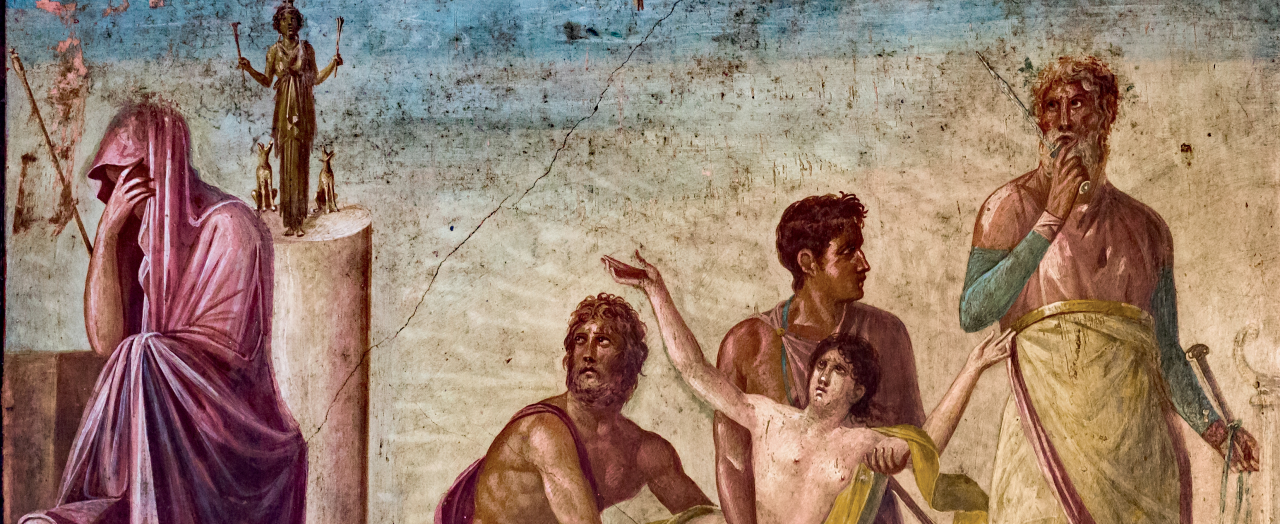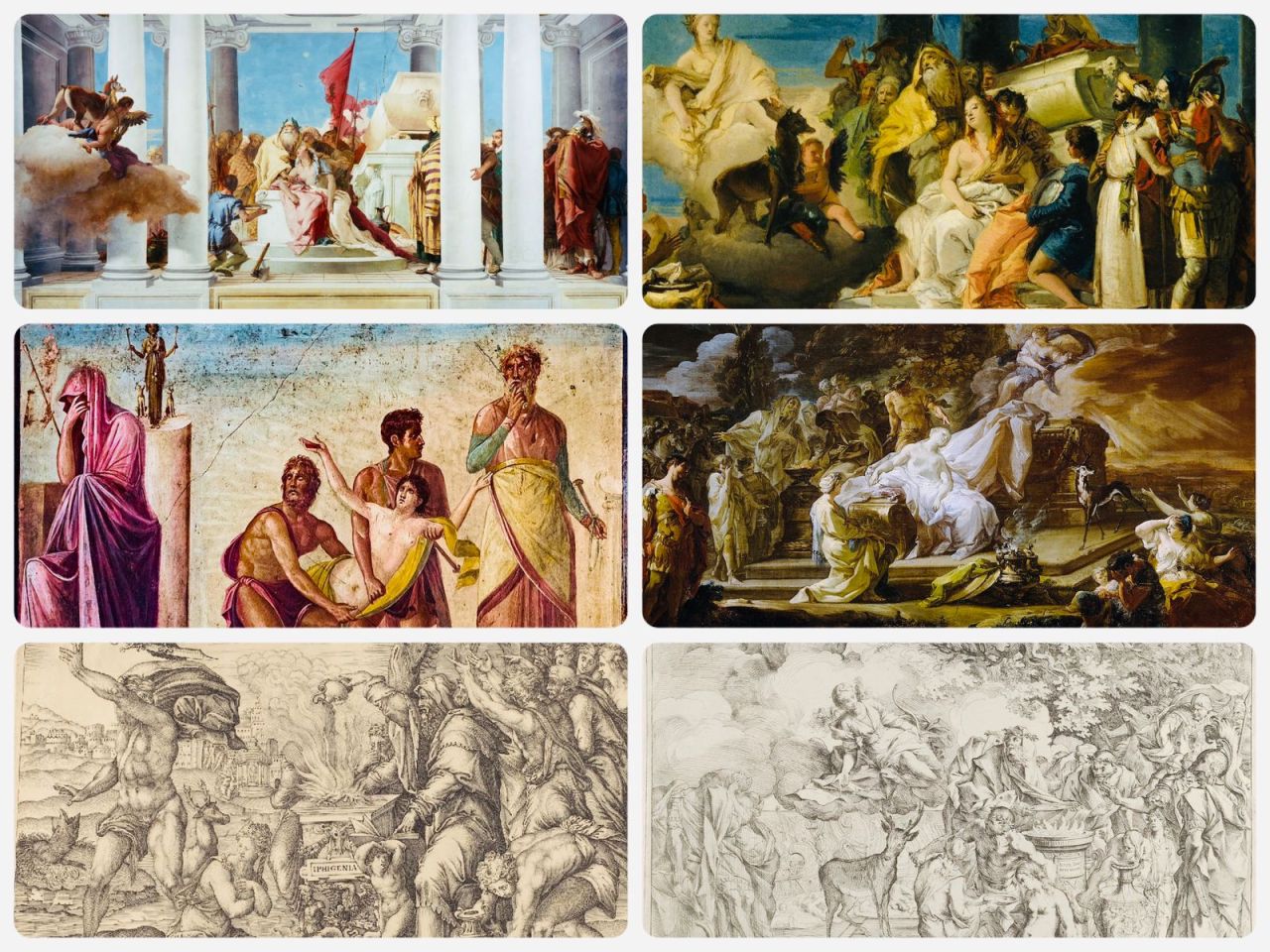A father’s sorrow - The sacrifice of Iphigenia in Ancient Greek art.
I’m bringing you this beautiful post to share some historical moving and touching facts. In modern fiction, Agamemnon is unfairly portrayed as some evil father and a cold-blooded man, when, the ancient Greeks depicted him in a very different light.
The artist Timanthes of Cythnus painted “The sacrifice of Iphigenia” and his portrayal of Agamemnon was praised by many different authors and thinkers as genius and brilliant. It was a piece worthy of the most admiration.
In Natural History (Book 35) Pliny the Elder commented:
As to Timanthes, he was an artist highly gifted with genius, and loud have some of the orators been in their commendations of his Iphigenia, represented as she stands at the altar awaiting her doom. Upon the countenance of all present, that of her uncle (Menelaus) in particular, grief was depicted; but having already exhausted all the characteristic features of sorrow, the artist adopted the device of veiling the features of the victim’s father (Agamemnon), finding himself unable adequately to give expression to his feelings. There are also some other proofs of his (Timanthes’) genius…
Others like Cicero (Oratoria XXII 74), Quintilian (l.c.), and Valerius Maximus (8.11. ext. 6) also praised Timanthes’ choice of depicting Agamemnon as veiled, and even Euripides echoed this image in his Iphigenia in Aulis:
As soon as we reached the grove of Artemis, the child of Zeus, and the flowery meadows, where the Achaean troops were gathered, bringing your daughter with us, at once the Argive army began assembling; but when king Agamemnon saw the maiden on her way to the grove to be sacrificed, he gave one groan, and, turning away his face, let the tears burst from his eyes, as he held his robe before them.
There is an interesting analysis by Henry Fuseli about Timanthes’ painting that says:
Timanthes felt like a father : he did not hide the face of Agamemnon, because it was beyond the power of his art, not because it was beyond the possibility, but because it was beyond the dignity of expression, because the inspiring feature of paternal affection at that moment, and the action which of necessity must have accompanied it, would either have destroyed the grandeur of the character, and the solemnity of the scene, or subjected the painter with the majority of his judges to the imputation of insensibility. He must either have represented him in tears, or convulsed at the flash of the raised dagger, forgetting the chief in the father, or shown him absorbed by despair, and in that state of stupefaction, which levels all features and deadens expression; he might indeed have chosen a fourth mode, he might have exhibited him fainting and palsied in the arms of his attendants, and by this confusion of male and female character, merited the applause of every theatre at Paris. But Timanthes had too true a sense of nature to expose a father’s feelings, or to tear a passion to rags…
This motif of Agamemnon hiding his face would be repeated throughout art history. We have other examples like the etchings of Nicolas Béatrizet (1553), the painting of Corrado Giaquinto, the etching of Pietro Testa (1640) or Giovanni Battista Tiepolo’s painting in Villa Valderana, and other paintings of the same artist.
Love, sorrow, duty, and public duty were some of the key concepts, as Ovid tells in his Metamorphoses XII, 24-34: The public good at last prevailed above affection, and the duty of a king at last proved stronger than a father’s love. In my Spanish translation: “the state’s sake defeated the love for a daughter, the king defeated the father”. Agamemnon says in Sophocles’ Ajax: “To put country before children befits a king”. This might be one of the most complex myths (if not the most) from Greek mythology, and it’s sad how now, in modern fiction, it has been deprived of all context, religion, and spirit.
SOURCES:
- Euripides’ Iphigenia in Aulis - Perseus / Gredos, Eurípides, Tragedias II, 2006, España-
- Los mitos en el Museo del Prado - Miguel Ángel Elvira Barba, Marta Carrasco Ferrer. 2018, España. Escolar y Mayo Editores. + Museo del Prado
- The sacrifice of Iphigenia and the veil of Timanthes - Michael Lahanas (Hellenica World)
- The sacrifice of Iphigenia - Pietro Testa. MET Museum
- The Sacrifice of Iphigenia - Nicolas Béatrizet. Google Arts.
- Gli affreschi - Villa Valmarana.com
- Perseus Dictionary, Timanthes.
- The life and writings of Henry Fuseli.
tobeblunt-forthehourislate liked this
treestar liked this
theautismarcana liked this
floweramon reblogged this from coloricioso
buffyannesummers99 liked this
 eosophia liked this
eosophia liked this athamad liked this
nestories liked this
 common-blackbird liked this
common-blackbird liked this  natache reblogged this from coloricioso
natache reblogged this from coloricioso  deathuc liked this
deathuc liked this coloricioso reblogged this from coloricioso
 sodasora123 liked this
sodasora123 liked this leviacoffe liked this
duckduck-goose liked this
fujoch100-blog liked this
tweedstoat liked this
 hozukitofu reblogged this from coloricioso
hozukitofu reblogged this from coloricioso  hozukitofu liked this
hozukitofu liked this  livelybook liked this
livelybook liked this  fruitydreamsandschemes liked this
fruitydreamsandschemes liked this bothshelterandwarningatonce liked this
artaxdies liked this
 dijeh reblogged this from coloricioso
dijeh reblogged this from coloricioso a0random0gal liked this
 venusfreyja liked this
venusfreyja liked this  valeee9 liked this
valeee9 liked this  machiavellianjane liked this
machiavellianjane liked this  kurara-black-blog liked this
kurara-black-blog liked this  smoothrools liked this
smoothrools liked this fairy-anon-godmother liked this
 jojogigi liked this
jojogigi liked this livingmeatloaf reblogged this from coloricioso
 grandprunecowboypalace-blog liked this
grandprunecowboypalace-blog liked this blackbearmagic liked this
lilflowergoddess liked this
beej-the-icebox liked this
peresephones reblogged this from thrassa
 fionaapplesvocalchords liked this
fionaapplesvocalchords liked this 6feet-aboveearth liked this
nataagria reblogged this from coloricioso
apolloandsunshine reblogged this from coloricioso
secretceremonials reblogged this from coloricioso
secretceremonials liked this
mkh-draws liked this
 thrassa reblogged this from coloricioso
thrassa reblogged this from coloricioso  thrassa liked this
thrassa liked this - Show more notes


